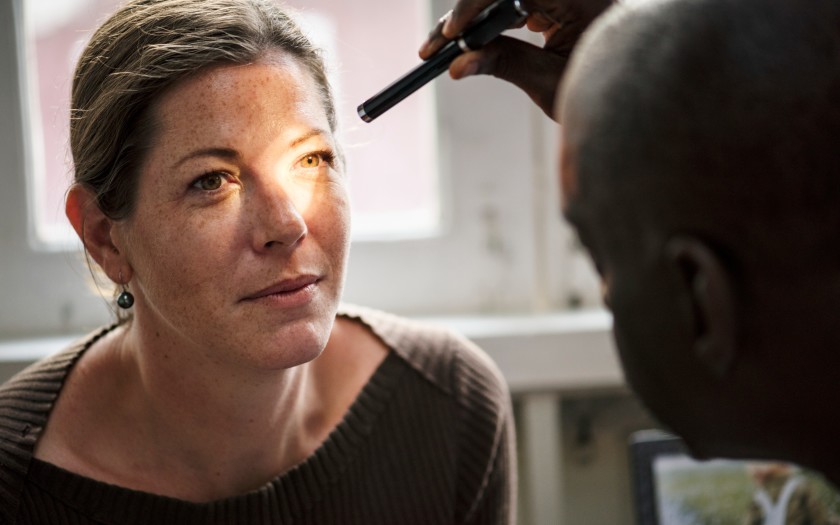
Snow Blindness: Symptoms & Prevention
The winter season, with its picturesque snow-blanketed landscapes and festive cheer, also ushers in the possibility of a temporary yet discomforting eye condition known as snow blindness. This condition, which can cause discomfort and even impair vision, primarily occurs due to the reflection of ultraviolet (UV) rays from surfaces such as snow and ice. It poses a risk to anyone engaging in outdoor winter activities without adequate eye protection.
Whether you're a frequent participant in winter sports or reside in a region with severe winter weather, being aware of the risks to your eye health during this season is crucial. To effectively prevent and treat snow blindness, continue reading to learn about this condition’s causes and symptoms from experts at Nationwide Vision.
What is Snow Blindness?
Snow blindness, medically named photokeratitis, is like getting a sunburn on your eyes instead of your skin. It arises when the cornea, the eye's transparent front surface, receives an excessive amount of ultraviolet (UV) rays. Unlike other eye conditions that typically develop over an extended period, snow blindness can occur quite rapidly, especially in environments with strong UV exposure. Although this condition is often temporary, it can cause a spectrum of effects ranging from mild discomfort to severe pain and even temporary vision impairment.
The cornea plays a vital role in protecting the eye, but its clear and forward-facing position leaves it susceptible to UV damage. Prolonged exposure to intense UV rays can damage or destroy the cells in the cornea, leading to inflammation. This bodily response to heal the damaged cells is what triggers the symptoms associated with snow blindness. Additionally, the high reflectivity of snow, capable of reflecting up to 80% of UV rays, significantly heightens the risk of UV exposure to the eyes during the winter season.
Snow Blindness Symptoms
Even though it is a temporary condition, snow blindness can lead to significant discomfort and can disrupt your daily routine. Some of the most common symptoms of snow blindness include:
Pain or Discomfort: The typical first sign of snow blindness is a distinct pain in your eyes. This discomfort can vary from mild irritation to intense burning, like sand in your eyes.
Tearing or Wateriness: You may experience excessive tearing or wateriness with snow blindness. This is your eye’s natural way of flushing out any debris and mitigating irritation.
Blurred Vision: When UV rays damage your cornea, the normal sharpness of your vision is affected, causing blurriness.
Eye Redness and Eyelid Swelling: Another way your body naturally responds to UV damage is through redness and swelling, which typically clear up as the cornea heals.
Temporary Vision Loss: In extreme cases, you may lose your vision temporarily as you deal with snow blindness. While this symptom is rare, it will typically heal as your snow blindness symptoms subside.
Who is At Risk of Developing Photokeratitis?
The main cause of snow blindness is the strong reflection of ultraviolet (UV) rays from snow-laden surfaces. This reflection can be misleading as it can take place even on cloudy days or in areas that appear to be in the shade. Additionally, altitude plays a crucial role in the development of snow blindness. At higher elevations, UV radiation is more intense due to the thinner atmospheric layer, which provides less natural protection against these rays.
Snow blindness poses a risk for anyone engaging in outdoor winter activities. People who are avidly involved in outdoor sports, like skiing, snowboarding, and mountain hiking, face a higher risk. This increased risk is due to their extended exposure to elevated UV levels, particularly pronounced on snow-covered surfaces and at higher altitudes.
However, the risk of snow blindness isn't confined solely to those who participate in winter sports. Individuals living in regions with extended winter seasons, in areas of high altitude, or in places with highly reflective environments, such as areas blanketed with snow, are also more likely to experience snow blindness. The interplay of bright, reflective surroundings and the thinner air found at higher elevations compounds the risk, underscoring the importance of taking precautions during the winter months.
Preventing Snow Blindness
Even if you have a higher risk of developing snow blindness because of your location or activities, there are a few easy ways to protect your eyes from excessive UV radiation.
Sunglasses and Goggles: The primary defense against snow blindness is wearing sunglasses or goggles that provide 100% UV protection. These eyewear options not only block harmful UV rays but also reduce glare from snow and ice. For activities like skiing or mountaineering, consider using a wraparound style for better coverage and protection against UV rays from all angles.
Hats or Caps: Adding a hat with a brim to your winter wardrobe is an easy way to reduce the amount of UV rays reaching your eyes.
Limiting Exposure: If you live or work in an area with many reflective surfaces, take regular breaks in shaded areas to minimize extended UV exposure.
Environmental Awareness: Throughout the winter, be mindful of your time in highly reflective environments, such as snow-covered landscapes or high-altitude regions.
Most importantly, whenever you spend time outside this winter, make sure to wear sunglasses or UV-protection goggles to shield your eyes from harmful UV rays and prevent snow blindness.
Treat Snow Blindness at Nationwide Vision
If you notice that your symptoms haven’t improved after 24-48 hours, if your vision has substantially worsened, or if you're experiencing severe pain, it's essential to promptly seek medical attention at your nearest Nationwide Vision. Our experienced optometrists are ready to provide you with medicated eye drops to effectively manage your symptoms and will arrange follow-up appointments to keep a close eye on your recovery. With quick and appropriate care, the majority of patients experience a complete recovery within just a few days.
As you prepare for the winter season, set an appointment with your local Nationwide Vision for an eye exam. Our team can ensure your eyes can handle increased UV exposure this winter.